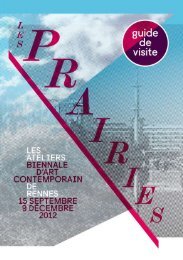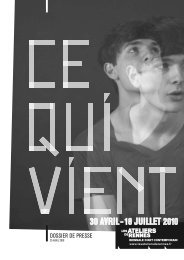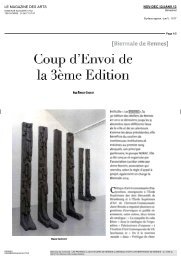Download here the Visitor's guide. - Les Ateliers de Rennes
Download here the Visitor's guide. - Les Ateliers de Rennes
Download here the Visitor's guide. - Les Ateliers de Rennes
Create successful ePaper yourself
Turn your PDF publications into a flip-book with our unique Google optimized e-Paper software.
MARIETA CHIRULESCU<br />
Stop, 2010. Courtesy of <strong>the</strong> artist and galery Micky Schubert,<br />
Berlin.<br />
RENé DANIëLS<br />
René Daniëls's meteoric career took place for <strong>the</strong><br />
most part between 1977 and 1987, coinciding with <strong>the</strong><br />
time when <strong>the</strong> Neo-expressionist movement came to<br />
dominate <strong>the</strong> art market. In 1987 Daniëls was affected<br />
by a brain haemorrhage and did not paint again until<br />
2006. In 1984 an invasive pattern emerged. It was a<br />
perspective space with two or three walls, usually<br />
without floor or ceiling. This enigmatic, ambivalent<br />
shape often took <strong>the</strong> form of a bow tie – it is worn by<br />
<strong>the</strong> artist in a drawing entitled A Room above <strong>the</strong><br />
Pacific; it is a pictogram satirising <strong>the</strong> bourgeois<br />
atmosp<strong>here</strong> of exhibition openings; but in Battle<br />
for <strong>the</strong> Twentieth Century, <strong>the</strong> scarlet bow tie is<br />
pierced with yellow openings – windows, or perhaps<br />
monochrome paintings, which transform <strong>the</strong> bow<br />
tie into an exhibition space. It is an alluring mise en<br />
abyme: from <strong>the</strong> painting in <strong>the</strong> exhibition space to<br />
<strong>the</strong> exhibition within <strong>the</strong> space of <strong>the</strong> painting. At that<br />
same time, <strong>the</strong> British artists Michael Baldwin and<br />
Mel Rams<strong>de</strong>n from Art & Language created a similarly<br />
<strong>de</strong>populated embedding of concepts in <strong>the</strong>ir series<br />
Inci<strong>de</strong>nts in a Museum. Daniëls's diptych Title Evening<br />
sabotages perspective in a similar kind of way. His<br />
target is once again <strong>the</strong> fiction of <strong>the</strong> painting and its<br />
exhibition, <strong>the</strong> vacuity of too focused and abstracted<br />
a view.<br />
H. M. tr. J.H.<br />
Born in 1950 in Eindhoven (Ne<strong>the</strong>rlands), w<strong>here</strong> he<br />
lives and works.<br />
<strong>Les</strong> Prairies's artists<br />
Marieta Chirulescu has managed to escape <strong>the</strong> usual schism that<br />
divi<strong>de</strong>s <strong>the</strong> digital sect from <strong>the</strong> sacrosanct chapel of traditional<br />
photography. Her pictorial ecumenicalism embraces digital<br />
and analogue, painting and photography, Photoshop and <strong>the</strong><br />
photocopier. Her works, which can be likened to filters or veils<br />
or colour projections, often have <strong>the</strong> effect of a nebulous mist<br />
whose <strong>de</strong>pth rises above <strong>the</strong> surface and whose bor<strong>de</strong>rs are<br />
unclear. It can be difficult to make out <strong>the</strong> grain because <strong>the</strong> effect<br />
of digital enlargement is so similar to <strong>the</strong> weave of a painted<br />
canvas. It is also hard to differentiate between <strong>the</strong> margins and<br />
<strong>the</strong> edges. They are superimposed in a stratigraphy that <strong>de</strong>fies<br />
interpretation. Chirulescu's taste for interference – a forgotten<br />
scrap of scotch tape <strong>here</strong>, a scratch t<strong>here</strong>, dust, reflections,<br />
misalignment, and so on – is perhaps a product of her Romanian<br />
childhood, spent reading badly printed books. Images from<br />
<strong>the</strong> internet, screenshots, photos taken by her fa<strong>the</strong>r during <strong>the</strong><br />
dictatorship, and illustrations from <strong>the</strong> old Romanian journal Arte<br />
have all been treated in a way that apes <strong>the</strong> style of archival and<br />
bureaucratic processes. Chirulescu apparently works towards an<br />
exhaustiveness which would explain <strong>the</strong> washed out, overexposed<br />
tones of anaemic images. Her use of layering software is done<br />
to achieve impalpable tactile effects – <strong>the</strong> aim is to remove <strong>the</strong><br />
presence not <strong>the</strong> virtual nature of <strong>the</strong> image.<br />
H. M. tr. J.H.<br />
Born in 1974 in Sibiu (Romania), lives and works in Berlin<br />
(Germany).<br />
Painting on <strong>the</strong> Bullfight, 1985. Courtesy Bonnefantenmuseum, Maastricht.<br />
Photography : Peter Cox. © Adagp, Paris 2012.<br />
43






